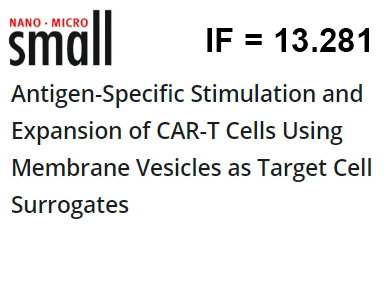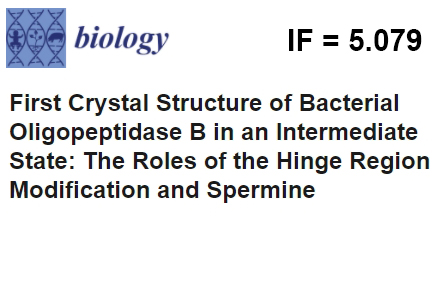Press-room / Digest

Antigen-specific stimulation and expansion of CAR-T cells using membrane vesicles as target cell surrogates
Development of CAR-T therapy led to immediate success in the treatment of B cell leukemia. Manufacturing of therapy-competent functional CAR-T cells needs robust protocols for ex vivo/in vitro expansion of modified T-cells. In this work, a team of scientists from the IBCh RAS in collaboration with a group of scientists from Dmitry Rogachev National Medical Research Center and colleagues from the Faculty of Biology of Moscow State University have created a new technology for the expansion of CAR T cells using artificial vesicles carrying surface tumor antigens. This approach will allow in the future to obtain CAR T-cells with improved functional properties and to minimize the level of premature "exhaustion" of the CAR T-cell population. This work was supported by Russian Scientific Foundation project No. 17-74-30019 and by the Russian Foundation for Basic Research grant No. 19-29-04087_mk and published in the Small journal. Learn more

Development of single-domain inhibitory antibodies targeting the ErbB3 receptor for cancer therapy
The human ErbB3 receptor is an important pharmacological target in the treatment of various types of cancer. A variety of anti-ErbB3 monoclonal antibodies are currently in development and are classic immunoglobulins. However, the search for new sources of antibodies or nanoantibodies consisting only of the heavy chain is being conducted more and more actively. Thus, in this work, a team of scientists from the Laboratory of Biocatalysis of the IBCh RAS, together with colleagues from the Laboratory of Renewable Energy Sources of the Academic University discovered a group of new single-domain llama antibodies targeting the extracellular domain of ErbB3 using the phage display method. It was found that the single-domain antibodies are not only highly affine for various receptor epitopes, but also have an inhibitory effect on the growth of tumor cells expressing ErbB3. This work was financially supported by the Ministry of Science and Higher Education of the Russian Federation (No. 0791-2020-0006) and ZAO Biocad and published in the journal Biomedicines. Learn more

Engineered Removal of PD-1 From the Surface of CD19 CAR-T Cells Results in Increased Activation and Diminished Survival
A promising approach in tumor therapy is the use of T cells armed with the recombinant Chimeric T cell Receptors (CAR). Unfortunately, the CAR-T cell therapy is effective currently only for the treatment of hematologic malignancies. The major issue that limits practical usefulness of the CAR-T technology is cancer microenvironment, which suppresses activation of the CAR-T cells. A collaboration of scientists from IBCh RAS and other Russian and foreign institutes has modified T cells with CD19-CAR and reduced the expression PD-1 at the same time. Unexpectedly, despite increased activation of CAR-T cells with low level of PD-1, these T cells had reduced survival and diminished cytotoxicity. This work was supported by the Ministry Education and Science of the Russian Federation (Grant No. 075-15-2020-773) and published in Frontiers in molecular biosciences. Learn more

DARPin_9-29-Targeted Gold Nanorods Selectively Suppress HER2-Positive Tumor Growth in Mice
A team of scientists from the Laboratory of molecular immunology of the IBCH RAS in collaboration with colleagues from Prokhorov General Physics Institute and Tel Aviv University developed innovative functional nano-biomaterials for selective photothermal therapy of HER2-positive breast cancers. It was demonstrated that gold nanorods (GNRs) stabilized with bovine serum albumin (BSA) and chemically conjugated to targeted vehicle specific to HER2 can be used for near infrared ablation of HER2-positive cancer in animal model. Stabilization of GNR with BSA leads to increase tumor uptake 16-fold in compare to naked GNR. As a result, photothermal therapy of HER2-positive tumor-bearing mice with HER2-specific BSA-stabilized GNRs leads to increase tumor growth inhibition coefficient in 2.5-fold compared to naked HER2-specific GNRs. Results are published in Cancers. Learn more

First crystal structure of bacterial oligopeptidase B in an intermediate state: the roles of the hinge region modification and spermine
Oligopeptidase B (OpB) is a two-domain serine peptidase with trypsin-like substrate specificity. OpB belongs to the prolyl oligopeptidase (POP) family and are found only in bacteria and protozoa. It is known that OpB are pathogenesis factors of protozoan infections and protect bacterial cells from a number of antimicrobial peptides. Nevertheless, they are the least studied representatives of POP, especially bacterial OpB, for which there was a complete lack of structural information. The researches from IBC RAS together with those of NRC Kurchatov Institute and the IBOC of the National Academy of Sciences of Belarus managed to obtain crystal structures of bacterial OpB from Serratia proteomaculans (PSP) with a modified hinge region. The work was published in the Biology journal. Learn more

